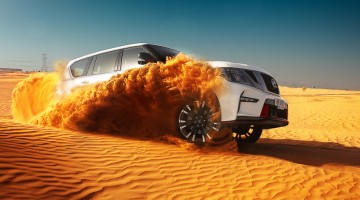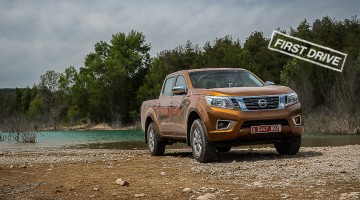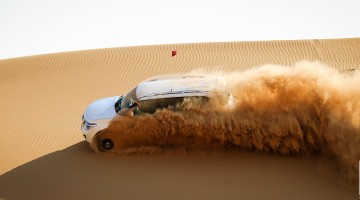For 2017, the ‘most significant changes yet’ have been implemented on the Nissan GT-R R35. But how has this affected performance? crankandpiston.com finds out at the Dubai Autodrome
| Engine | Power | Torque | 0-100kph | Top speed | Weight | Basic price |
|---|---|---|---|---|---|---|
| V6, twin-turbo, 3799cc | 562bhp @ 6800rpm | 467lb ft @ 3300-5800rpm | 2.7sec (claimed) | 315kph | 1752kg (321bhp/ton) | $134,800 |
| Still excellent performance but with greater refinement | |
| Fanboy backlash awaits this ‘softer’ GT-R |
—
Okay, deep breath, caps lock button at the ready…I’ve never been a big fan of the Nissan GT-R.
Sorry, but it’s true. When the Nissan GT-R first appeared as the Skyline’s successor 10 long years ago, it was easy to get swept along with the hyperbole. Here for instance was a Nissan that yearned to be something more than the characterless dross boxes the company had made a habit of producing, and the yawning chasm of performance between the GT-R and the much pricier Porsche Carrera S proved as such.
But, truthfully, on my first drive, I really didn’t know what the fuss was about. Vertebrae-snapping 0-100kph launch runs were all well and good, but there was a distinct lack of civility in the more agricultural GT-R’s cabin, with a surprisingly high seating position, a dashboard clunky to the touch, and a too-fussy centre console. It just didn’t press my eruption buttons.
A decade on though, Nissan has seemingly sat up and taken notice, as evidenced by words like ‘premium’ and ‘luxury’ in the marketing material, once unthinkable when talking about the 911 destroying underdog. As well as being, potentially, the most sophisticated GT-R yet, Nissan has made bones that this comprehensive facelift marks ‘the most significant changes to R35 since the model was introduced in 2007.’ Wearisome marketing pre-amble aside, there is truth to that statement in the cabin alone.
What’s the design like?
Well, the once cluttered centre console has been hacked apart, 27 instrument buttons now becoming 11 and instrumentation for the enlarged 8in touchscreen considerably less rage-inducing to use than its predecessor. The Nappa leather-clad dashboard – complete with new ‘horizontal flow styling’ – both looks and feels more plush than the old example, and improved sound insulation means the graunching sounds of the transmission whirring beneath is less intrusive. Even the paddle-shifters have been mounted to the steering wheel rather than the column to make sure you’re never crossed up, a small but clever change in its detailing.
Not that Nissan has completely forsaken performance of course. The new front end borrows the restyled front bumper, more aerodynamically chiselled bonnet and larger front grille from the 2014 GT-R NISMO to improve airflow. Tweaks at the rear are somehow even more subtle, with the familiar round taillights now teamed with a silver finish diffuser, new side air vents and a NISMO-spec rear bumper to reduce drag that the improved airflow at the front threatened to derail. Even the engine, the same 3.8-litre twin-turbo V6 as its predecessor, kicks out an additional 20bhp for a 562bhp total, 467lb ft of torque helping to hover the 0-100kph time around the 2.7 seconds mark. We assume anyway, since Nissan’s tiresome efforts to add an air of ‘mystique’ to the GT-R mean performance figures, annoyingly, weren’t initially confirmed.
You’d assume then that performance would, if anything, also be subtly improved, given the stiffened body shell and well-hidden 1752kg kerb weight. That would be to forget the newly softened suspension, which, on-track at least, does make a difference.
Talk about the handling…
Don’t get me wrong, the V8 under acceleration still feels bullwhip-like in its immediacy, the front end positively straining to break free in an impressive impersonation of understeer as I feed the power back in on corner exit at the Dubai Autodrome (fortunately there’s more than enough front end grip to keep the nose reigned in). There’s a solid wallop of low down pick-up that builds like a metronome past the mid-range revs and up towards the redline, ratchet-like changes through the admittedly out-dated six-speed dual clutch gearbox ensuring momentum continues to build. Sorry Nissan, but it just can’t compete with the immediacy and panache of Porsche’s seven-speed PDK. The good news is that the brakes remain sharp and well-tempered, even if the rear end does start to squirrel under heavy deceleration, despite the best efforts of the rear-biased all-wheel drive system.
Acceleration then is certainly more ‘R’ than ‘GT’ in the 2017 model, but it’s through the corners where the intricacies reveal themselves. Yes, the steering is well-weighted, if perhaps offering a little more heft than you might expect, meaning the front end really has to be muscled when you’re truly on it. Turn-in is sharp and pinpoint, if perhaps not quite as rampant as its predecessor. The newly refined GT-R will still handle like it’s on rails – regardless of whether you unleash the rear wheels into progressive oversteer – but Nissan does seem to have dialled back on the savagery, meaning turn-in and mid-corner balance, while still excellent, doesn’t quite feel as unhinged as before, the newly softened suspension throwing its well cushioned hat into the arena here. How that transfers to road comfort we’ll have to wait and see for a fuller off-track regional drive.
Overall verdict?
So, the ‘most significant changes’ to the GT-R in a decade do feel, when given the absolute beans, a little softer than the model it replaces. Even two years ago, such a thing would have led to message board lynchings. Remember though that times have changed since the GT-R first arrived. No longer must it be the epitome of Nissan performance, given the arrival of both the NISMO and the thoroughly honed Track Edition. Like its principal rival from Stuttgart, the now ten-year old R35 can afford to relax its well-tightened performance capabilities in favour of a dash more civility and refinement. Many of you, I’m sure, will disagree with such a notion. But for me, never a huge fan of the GT-R to begin with, it simply makes Nissan’s halo sportscar the all-round package it deserves to be.
- Check out our hot lap with the 2017 Nissan GT-R HERE






